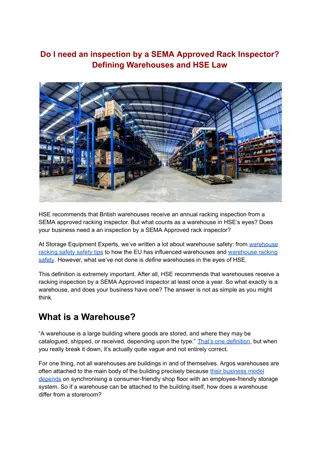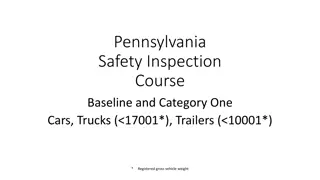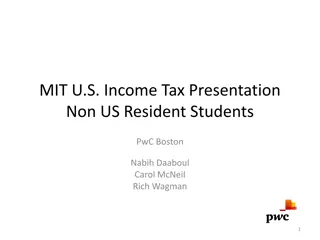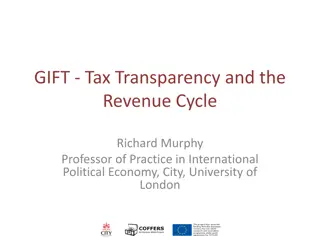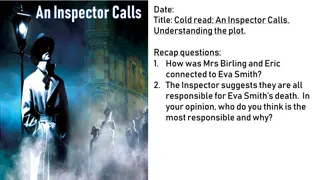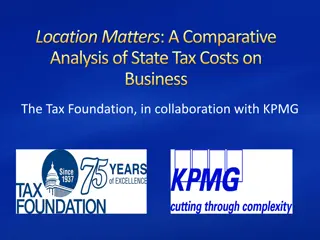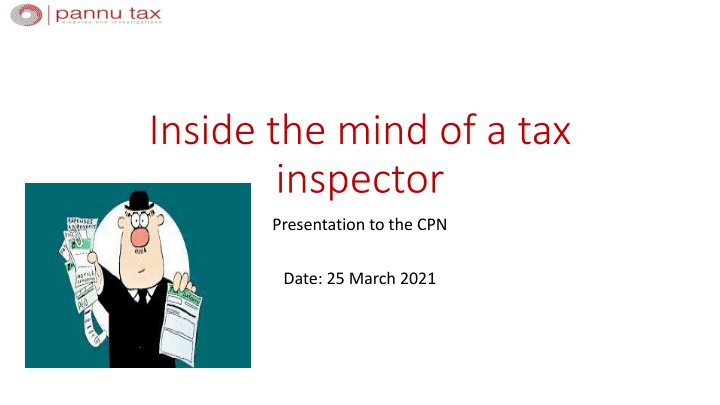
Inside the Mind of a Tax Inspector: Insights into Dealing with HMRC and Its Responsibilities
Explore the world of tax inspectors with insights on dealing with HMRC, client feedback, HMRC's role as an organization, responsibilities, strategic objectives, and the tax gap. Understand the dynamics and challenges faced in tax collection and compliance.
Download Presentation

Please find below an Image/Link to download the presentation.
The content on the website is provided AS IS for your information and personal use only. It may not be sold, licensed, or shared on other websites without obtaining consent from the author. If you encounter any issues during the download, it is possible that the publisher has removed the file from their server.
You are allowed to download the files provided on this website for personal or commercial use, subject to the condition that they are used lawfully. All files are the property of their respective owners.
The content on the website is provided AS IS for your information and personal use only. It may not be sold, licensed, or shared on other websites without obtaining consent from the author.
E N D
Presentation Transcript
Inside the mind of a tax inspector Presentation to the CPN Date: 25 March 2021
What is it like dealing with HMRC? Client feedback Uncertain Uncommercial Challenging Time consuming Exasperating Worrying What does HMRC say? Make things easy Responsive Treated fairly Impartial Effective Accessible
HMRC as an HMRC as an organisation organisation
What type of organisation is HMRC? Collected 636bn in year to 31 March 2020 (pre pandemic!) Established by Commissioners for Revenue & Customs Act 2005 Non ministerial department Report to Parliament through Treasury Minister Treasury lead on tax policy/HMRC lead on maintenance & admin S5 CRCA 2005 HMRC responsible for collection and management of tax Duty of care & management Treat taxpayers equally and fairly Governance & accountability Dealing with HMRC is not a always a commercial negotiation
What is HMRC responsible for? Income Tax, CT, CGT, IHT, IPT, SDLT and PRT Environmental taxes Climate change and aggregates levy and landfill tax Value Added Tax (VAT), including import VAT Customs duty Excise duties Trade Statistics NIC s Tax Credits Child Benefit National Minimum Wage Student Loan repayments
What are HMRCs strategic objectives? Per HMRC Annual Report: Collect Revenues due and bear down on avoidance and evasion Transform tax and payments for customers Design & deliver a professional and engaged organisation Wider objectives Leading digital change across public services Budget 2021 95m to deliver digital technology Creation of a tailored single tax account Behavioural based approach
Tax Gap Difference between the amount of tax that should, in theory, be paid to HMRC, and what is actually paid Currently stands at 4.7% Lowest ever tax gap In monetary terms - 30.8bn
Tax Gap - segmentation Segment Amount ( bn) Percentage Failure to take reasonable care 5.5bn 18% Legal interpretation 4.9bn 16% Tax Evasion 4.6bn 15% Criminal Attacks 4.5bn 15% Non payment of tax 4.1bn 13% Errors .3.1bn 10% Hidden Economy 2.6bn 8% Tax avoidance 1.5bn 5%
The good old days?? ..Versus Today Then Now Network of local Tax Offices All functions integrated Direct/indirect tax autonomous Manual processes Local selection of enquiry cases Investigation based approach 13 Regional Centres Business Directorates Joined up/Cross tax enquires Automised processes RIS team Campaigns/Audit/Interventions based approach
What is it like to work in HMRC? Per HMRC Employee Survey 2019 (Agree or Strongly agree): I am interested in my work 81% I have a clear understanding of HMRC s objectives 78% I believe actions of senior managers are consistent with HMRC values 45% Overall I have confidence in decisions taken by senior managers - 34% When changes are made in HMRC they are usually for the better 23%
The tax landscape The tax landscape
Tax and regulatory environment What does this mean in practice? Response Dramatic increase in legal and regulatory compliance Increased reporting obligations Change in HMRC approach Focus on people responsible for the loss of tax Public perception/reputation Increased focus on data Lower risk appetite Governance more important Certainty on tax positions Mitigating risk
Tax & regulatory environment Large business - Tax in the Boardroom , tax policy, SAO, Risk reviews Multinationals - BEPS Offshore - Common Reporting Standard UK Regulatory Money Laundering regulations Bribery Act Corporate Criminal Offence UK - Litigation & Settlement Strategy UK New information powers (including right of inspection) UK - New Code of Governance for resolving tax disputes
Focus on tax avoidance & evasion Tax Avoidance Tax Evasion General Anti Abuse Rule APN s & Follower Notices Strengthening DOTAS DOTAS for indirect taxes Serial avoiders legislation Enablers of tax avoidance schemes Loan charge Requirement to Correct New penalty regime for offshore offences Corporate Criminal Offence Online marketplaces
Survey of larger businesses key issues Lower risk appetite Scrutiny from HMRC an important factor 57% Reputational Risk 38% Interventionist approach Increased regulation affects their business 67% Reputational risk Seek resolution by agreement 57% Litigate only in exceptional circumstances 33% Achieving settlements difficult Stuck in HMRC policy 39%
Building blocks of tax governance Tax Strategy Attitude to tax Covers 4 areas: Approach to risk management & governance Attitude towards tax planning Level of risk the group is prepared to take Approach with HMRC Tax Strategy Questions from HMRC Does it capture the actual approach? Is the tax strategy known? Board/senior management Across the business Is it used in decision making? How do you demonstrate this?
Building blocks of tax governance Operational Quality of underlying data Clearly defined/documented tax processes Adequate controls in place Testing of controls and processes Allows for accurate tax reporting Operational Questions from HMRC What is the quality of documentation? Is it consistent across the business? Are the controls the right controls? Show us evidence of testing Who reviews this and when? Operational
Building blocks of tax governance Tax control framework Key tax risks understood Appetite to risk understood Board/senior management engagement Understood/applied throughout the business Sufficient resources: People Processes Policies/training Tax control framework Questions from HMRC Is tax aligned with corporate strategy? How are tax controls defined and embedded? Is tax an integral part of the business? Is there a commonly understood risk appetite across the Group? Tax control framework Operational
HMRC organisation Large Business Turnover 500m+ Top 2,000 businesses in UK Appoint a Customer Compliance Manager Wealthy & Midsized Turnover 10m+ to 500m or at least 20 employees Customer segmention (focus on the business and not individual taxes) Individuals & Small Business Compliance Turnover up to 10m 35m individuals and small businesses
HMRC enquiries key considerations What type of enquiry is it? Who issued the enquiry/who is the Inspector (Is it an inspector?) What information do HMRC have? Is the information HMRC requesting reasonably required? Do HMRC have the right to raise enquiries/issue assessments? What safeguards are in place? Who is the decision maker? What is the settlement/governance process?
HMRC Risk & Intellegence Service (RIS) Based in Bristol Collates data for HMRC enquiries/campaigns/projects 3 main elements Analysis & information identifies compliance risk and threats Campaigns & National Projects Develops project work Operations Deliver risk intelligence packages All returns risk assessed Wide range of information sources from HMRC s systems If your clients do receive an enquiry it is likely HMRC have some information or reason to enquire
HMRC Connect database Introduced in 2010 - developed by BAE Systems Cost 100m Uses sophisticated data analytics A data matching & risking tool that allows us to uncover hidden relationships between people, organisations & data that we could not previously identify All information sources not known but it will interrogate over 30 databases containing billions of pieces of data Connect can search all those databases and collate information
HMRC Connect database - Information sources Tax returns Bank accounts Offshore data Credit reference agencies Credit card accounts Online activity (e.g.Paypal/Ebay) Companies House DVLA Land registry Online social networking Property websites (e.g. Rightmove) Flight sales Passenger information Local authority returns DWP
Connect Example of an Intelligence Package HMRC risk profile a shareholder of a company Married or divorced Children & private school Maintenance or Child Benefit Properties owned & mortgages Rental income received Bank deposits Bank borrowings Investments held Insurances Finance arrangements Cars owned/leased Council tax & other utilities Other business interests
HMRC Litigation & Settlement Strategy (LSS) What is it and why is it important? Introduced in 2007 Sets out the principles within which HMRC handles all tax disputes HMRC approach has 2 key elements: 1. Support customers to get it right, thereby avoiding disputes 2. Resolving disputes collaboratively to establish the right amount of tax at the least cost to HMRC and its customers
HMRC Litigation & Settlement Strategy (LSS) How do you reach agreement? Negotiated settlements are the norm HMRC will work with the taxpayer to: 1. Fully understand the relevant facts & law 2. Share & test the strengths and weaknesses of each others arguments 3. Reach a considered view on the strength of its case This is an opportunity to influence HMRC and reach an agreement
HMRC Litigation & Settlement Strategy (LSS) Litigation Where a dispute is genuinely all or nothing in nature and HMRC believes it would be likely to succeed in litigation, HMRC will not reach an out of court settlement for less than 100% of the tax due Where there are a range of possible figure for tax due, HMRC will not settle for an amount which is less than it would reasonably expect to obtain from litigation. If HMRC believes it would be unlikely to succeed in litigation, it will, in the majority of cases, concede the issue
How do you avoid a HMRC enquiry? Keep good records Take professional advice where appropriate Make use of white space disclosures on tax returns Make voluntary disclosures Use clearance procedure where appropriate Ensure tax returns and payments are up date Understand the consequences if you enter into tax avoidance arrangements Understand HMRC s powers (and safeguards in place) Effective dialogue/negotiation with HMRC
Future tax landscape? Future tax landscape?
Future tax landscape? Tax Policy & Consultations document Spring 2021 Presented by Treasury to Parliament Making Tax Digital extended - to apply to IT Self Assessment (April 2023) Investment in digital infrastructure Tax administration review changes to enquiry process & information powers More frequent payment of Self Assessment tax Raising standards in the tax advice market Off payroll working Clamping down on the promoters of tax avoidance Disguised remuneration and the loan charge Paying for Covid/Compliance
Coronavirus Support Payments 47.9bn paid out in furlough grants to Nov 2020 Estimated that 5%-10% error/fraud Budget 2021 - HMRC earmarked 100m & 1,000 extra staff for compliance Aggressive (behavioral) penalty regime Fraud Hotline & other HMRC intelligence Legislative support - Sch 16 FA 20 Uses existing HMRC powers
CSPs Assessments Sch 16 Finance Act 2020 If person not entitled to a CSP or ceases to be entitled: Due to a change in circumstances Person has not, within a reasonable period, used the amount for the purpose intended Tax due when payment received (or or the date they ceased to be entitled to the payment after it was received) Recipient liable to income tax on an amount equal to the CSP to which they are not entitled (i.e. 100% claw back) HMRC may make an assessment in the amount which ought in the officer s opinion be charged Assessment subject to HMRC time limits (4, 6 & 20 years) For partnerships assessment on any partner and there is joint and several liability (and penalties) Automatically treated as deliberate and concealed if the person knew they were not entitled to the CSP Prosecution in appropriate cases
Coronavirus Support Payments Cash costs (assessments & penalties) Joint & several liability for partnerships Naming & shaming No walk away through insolvency Significant penalty cost Effectively manage any HMRC audit HMRC information & inspection powers Clarity on technical aspects (e.g. employment law issues) Best judgement for assessments Effective negotiation /onus of proof etc Be proactive, establish the facts, behaviours & collate evidence to support What impact for the wider business?
Conclusions & thoughts Conclusions & thoughts
Conclusions & thoughts HMRC going through transformational change Changes in law & working practices affect us all Regulation increasing Appetite for risk is reducing HMRC have more information than ever before Keeping good records & taking professional advice will reduce the risk of enquiry or a tax dispute if HMRC do query a return
Questions? Questions?
Contact details Pannu Tax Ltd Richard Alderson richard@pannutax.co.uk O7739 874043

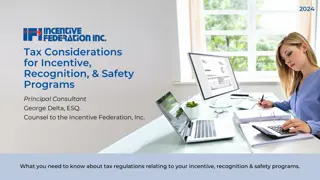
![Town of [Town Name] Real Estate Tax Rates and FY 2024 Budget Summary](/thumb/62211/town-of-town-name-real-estate-tax-rates-and-fy-2024-budget-summary.jpg)

